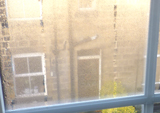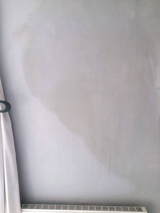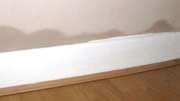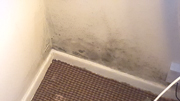

How to get rid of condensation and damp
To rid your home of condensation damp, the first step is to understand what type of damp you have.
All too often we have seen home-owners and landlords pay for the wrong repairs, resulting in money spent for no benefit.
You can use our Damp Home Diagnoser to help you understand which form of damp your home has, and what might be causing it.
If you do have a damp or condensation problem then the Damp Diagnoser is likely to tell you that your home suffers from one or more of the following:
Condensation

The most common damp problem, condensation is caused by too much humidity inside your home that cannot escape to the outside. Condensation is often mistaken for a leak or rising damp, because it can look as if the damp is coming in from the outside.
In many respects condensation is the worst form of damp because it allows mould (mold) to grow. Apart from unpleasant smells in your home (and on your clothes) mould is known to be damaging to your health.
To cure your home of condensation it is essential to have a small amount of constant air movement.
What you can do
- Try to encourage air to move around your home.
- Leave doors open or ajar (including the wardrobe in the master bedroom) when the house is unoccupied.
- If possible sleep with the bedroom door ajar.
- Leave the bathroom window open when having a shower and ideally keep it open until most of the moisture has gone.
- Make sure you keep the house at an adequate temperature.
- Be aware of the impact of any changes you make to your home.
What we can do
To really sort the problem out once and for all we can make the changes to your home necessary to improve air quality and drive out humid air. You can see more about our condensation solutions or contact us to arrange a survey.Penetrating damp

Penetrating damp is another name for a leak. This is caused by water coming in from outside. It can be quite straightforward to work out where a leak is coming from. However sometimes a damp patch will appear on a wall where there is no obvious defect on the outside.
What you can do
- Monitor the damp patch to see if it getting worse. You can draw a pencil line around the edge of the patch to see if it is getting larger.
- Stand outside in the rain ! Are the gutters discharging water against the walls, are there any obvious leaks.
- Think about where the damp patch is. Could it be caused by a leaking pipe, either in your house or even a leak in your neighbour's house that is coming through your wall.
Rising damp
Rising damp is caused by water being drawn up the through wall of the ground floor. This is more likely to affect older houses where the damp proof course has broken down or was never there in the first place.
House with solid concrete or stone floors can also be affected as it is easier for moisture to pass from the floor to the base of the wall.
Another complication is that because walls are colder towards the bottom - and therefore more likely to attract condensation - then the damp wall may be caused by humid air condensing on the cold wall.
It might look as though moisture has been drawn up through the wall when in fact it has come from humid air.


What you can do
Rising damp can be easy to misdiagnose and we have seen plenty of examples of remedial work to treat rising damp that was a condensation problem after all. So get different opinions before committing yourself to expensive remedial work.
And finally
If you get quotes or reports for remedial work make sure you understand the costs involved and the work that's proposed. Will it cure the problem you have ? what warranties or guarantees are being given ?
Don't be afraid to challenge the view being given - including ours !
High humidity + inadequate ventilation
= damp, condensation, mould

UK government advises:

